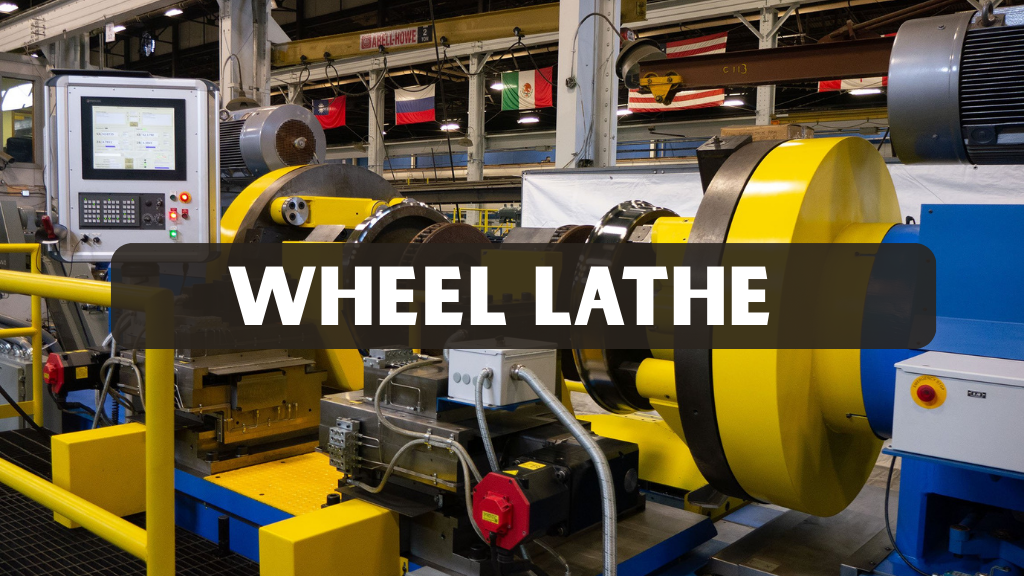A wheel lathe is a specialized machine tool designed to recondition, manufacture, and maintain wheels across industries including railways, automotive, aerospace, and heavy machinery. Unlike conventional lathes, it is built to handle heavy-duty wheel geometries with precision, ensuring safety and durability. In railway depots, for instance, underfloor systems allow re-profiling without dismantling the axle, saving time and reducing operational costs.
Modern CNC-enabled designs have elevated these machines by offering faster, smarter, and more accurate performance. Case studies from leading manufacturers, such as NSH Group, show businesses achieving up to 40% savings in wheel replacement costs through advanced lathes. Trusted worldwide, these machines not only meet regulatory standards but also support efficiency and reliability, making them a proven investment in critical industries.
What is a Wheel Lathe?
This machine tool is engineered specifically for machining wheel profiles with accuracy and consistency. It is capable of cutting, shaping, and restoring wheels to their original specifications, ensuring compliance with both safety and performance requirements. Industries such as railways, aerospace, and heavy equipment rely on this technology to extend wheel life and reduce operational risks. By reducing replacement needs, it provides a cost-effective solution for businesses.
Unlike conventional turning machines, it is designed to manage extremely heavy wheels, including those used in trains and industrial vehicles. Advanced designs allow re-profiling without removing the wheel from the axle, which significantly reduces downtime. By saving both time and labor during maintenance, it offers a dependable solution that has been proven effective in real-world applications. Many modern facilities now consider it an essential part of their long-term maintenance strategy.
Types of Machines for Wheel Applications
Wheel Lathe machines are specialized tools built for heavy-duty industries where safety and accuracy cannot be compromised. They are used to recondition, shape, and maintain wheels across railways, automotive, aerospace, and industrial sectors. Each type of machine has its own strengths, making it suitable for different applications. Choosing the right model not only improves performance but also ensures long-term reliability and reduced maintenance costs.
CNC-Controlled Models
CNC-controlled machines use digital programming to cut and shape wheels with exceptional precision. Their automated process minimizes human error, ensuring consistent results that meet strict industry standards. These machines are widely preferred in aerospace and advanced automotive manufacturing where accuracy is critical. They also allow businesses to save time by streamlining operations. With proper use, CNC models enhance both efficiency and safety in demanding environments.
Underfloor Systems
Underfloor lathe systems are designed specifically for railway operations where downtime must be minimized. They allow wheels to be re-profiled without removing them from the vehicle, saving hours of labor and reducing disruption. This setup is trusted in major railway depots worldwide for its efficiency and reliability. By extending wheel life and ensuring smooth operation, these systems directly contribute to passenger safety. Their proven performance makes them one of the most cost-effective solutions in large-scale transport.
Vertical and Horizontal Designs
Vertical lathe machines are specifically built to manage oversized and heavy components with exceptional stability and strong clamping. They are widely applied in heavy machinery industries where precision and durability are critical. Their robust design ensures long-term reliability, making them a trusted choice for demanding environments.
On the other hand, horizontal lathe machines are more suitable for medium-to-large wheels used in automotive and industrial applications. These models are valued for their versatility, covering a broad range of repair and maintenance needs. By combining vertical and horizontal designs, industries gain adaptable solutions that support both small-scale and large-scale operations effectively.
Industrial Applications
Wheel lathe machines play a vital role in railway systems, where they are used to re-profile train and metro wheels. By restoring the correct wheel geometry, these machines extend the service life of rolling stock and improve passenger safety. According to Wikipedia’s railway wheel maintenance overview, regular re-profiling reduces both wear and operational risks, ensuring reliability in high-demand networks
In the automotive sector, these machines are essential for manufacturing and maintaining car and truck wheels. They help ensure roundness, balance, and precision, which directly affect vehicle performance and fuel efficiency. Manufacturers rely on their accuracy to meet strict safety and quality standards demanded by global regulators.
Aerospace and heavy machinery industries also benefit from this technology. In aerospace, wheels are used to machine aircraft landing gear wheels with extreme precision, ensuring compliance with aviation safety requirements. For construction and mining equipment, they restore oversized wheels to working condition, improving durability in some of the toughest operating environments.
Benefits for Businesses
One of the major benefits of a wheel lathe is its ability to extend wheel lifespan through precise re-profiling. Instead of discarding worn wheels, industries can restore them to their original geometry. This ensures longer service cycles and greater safety for passengers and equipment. As a result, businesses save significantly on frequent replacements. Such accuracy also builds trust in maintenance quality.
These machines also reduce replacement costs by up to 60%, a figure often supported by real-world case studies. By maintaining balance and accuracy, they improve performance and reduce overall energy usage. This makes them especially valuable in high-demand sectors such as railways and automotive manufacturing. Efficiency gains also lead to fewer disruptions in operations. Over time, they deliver measurable financial savings.
Minimized downtime is another critical advantage, as specialized lathes enable quicker servicing compared to manual processes. Equipment and vehicles can return to service faster, ensuring productivity remains high. At the same time, they support sustainability by cutting material waste. This helps industries meet both cost-saving and environmental responsibility goals. Their role aligns with modern global efficiency standards.
Key Buying Considerations
When selecting a lathe machine for wheels, businesses should carefully evaluate capacity, automation, and durability. The maximum load and diameter a machine can handle determine its suitability for specific sectors, from railways to automotive. Modern CNC and digital features enhance precision, reduce human error, and support industries where consistency is critical. A durable, heavy-duty build ensures the machine can withstand years of use while maintaining accuracy and efficiency.
Equally important are factors such as manufacturer support and safety. Reputable suppliers offer spare parts, warranties, and service contracts, which minimize downtime and protect long-term investments. Safety features like emergency stops, protective guarding, and advanced sensors further safeguard operators while ensuring compliance with industry standards. By weighing these elements together, companies can make informed choices that balance performance, cost, and reliability.
Real-World Example
A European metro operator documented a 40% reduction in wheel replacement costs after implementing underfloor CNC systems. By restoring wheels instead of replacing them, the operator significantly lowered maintenance expenses while extending the service life of critical components. This result highlights the financial advantages of investing in advanced re-profiling technology.
Equally important, re-profiling was completed in under two hours per train, which reduced fleet downtime and improved overall availability. Passengers benefited from more reliable services, with fewer disruptions caused by wheel wear. The case demonstrates how modern machinery not only delivers cost savings but also enhances safety and operational efficiency in public transport networks.
Future Trends
The industry is steadily shifting toward advanced technologies that make wheel maintenance smarter and more reliable. AI-driven predictive maintenance is emerging as a powerful tool, helping operators forecast wear patterns before failures occur. IoT-based monitoring further supports this shift by enabling real-time performance checks, allowing maintenance teams to act quickly and reduce unexpected downtime. Together, these innovations improve safety and optimize operational costs.
Sustainability is also becoming a priority, with manufacturers introducing energy-efficient motor designs that lower power consumption and reduce environmental impact. In addition, robotic arms are being integrated into servicing processes, automating complex tasks that once required significant manual labor. This combination of efficiency, eco-friendly design, and automation reflects the future direction of industrial equipment, where performance, safety, and sustainability work hand in hand.
Conclusion
The wheel lathe remains an indispensable investment for industries where wheels face heavy wear and demanding conditions. Railways, automotive, aerospace, and heavy machinery sectors all rely on its ability to extend wheel life, reduce replacement costs, and enhance safety standards. By restoring wheels with precision, it safeguards both operational efficiency and long-term reliability.
With continuous advancements in CNC programming, automation, and eco-friendly engineering, the future of this technology looks even more promising. Businesses adopting modern solutions can expect greater efficiency, reduced downtime, and stronger sustainability outcomes. For companies seeking to balance performance with cost savings, investing in specialized machining equipment is not just practical but strategic.
FAQs
How does this machine differ from a conventional lathe?
It is specifically designed for handling oversized wheels, unlike standard machines that handle smaller parts.
How often should railway wheels be re-profiled?
Every 100,000 to 150,000 km, depending on wear and operational conditions.
What is the average investment required?
Costs range from $50,000 to over $500,000, depending on features and size.
Can old wheels be restored instead of replaced?
Yes, worn or damaged wheels can often be restored through re-profiling, which reduces replacement costs and extends service life.
Are CNC wheels better than manual models?
Yes, CNC systems provide higher accuracy, consistency, and automation, making them more efficient and reliable for industries handling large fleets or high-precision requirements.




